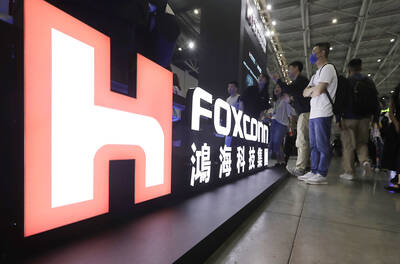Taiwan’s producers of liquid-crystal-displays (LCD) know that venturing into the Chinese market is risky, but they are also fully aware they have no choice, analysts said.
Even though they are major revenue earners, the island’s LCD makers got off to a late start, struggling for years to match stronger Japanese and Korean rivals, and they hope China will give them the leverage they need to catch up.
“We’re eager, if the government can give the go-ahead,” said Hsiao Ya-wen (蕭雅文) of AU Optronics (友達光電), the world’s third-biggest flat panel maker after Samsung Electronics Co and LG Philips Co.
AU Optronics currently operates two Chinese module plants — low-end facilities that do not give away much know-how — and announced in June plans for a third one in a joint venture with Sichuan Changhong Electric Co (四川長虹電器).
It could soon see its activities move to a whole new level. Economics Minister Shih Yen-hsiang (施顏祥) told parliament last week that Taiwan may relax curbs on high-tech investments in the mainland by local LCD companies.
A bigger role in China could be a huge boon for makers of LCDs — used in everything from cell phones to computers and e-books — because of the strong appetite among the mainland’s newly rich for cutting-edge electronic products.
The interest runs both ways, with AU Optronics vice president Paul Peng (彭雙浪) confirming recently that his company had received invitations from several Chinese city governments to set up plants once the high-tech curbs are eased. However, analysts also see risks that may face Taiwanese panel makers once they are permitted by the government to open up “eighth-generation” production plants in the mainland, introducing sensitive technologies.
“Chinese companies may ditch Taiwanese partners once they acquire their badly needed cutting-edge LCD know-how,” said Nancy Liu (劉美君), an analyst with Taiwan’s quasi-official Industrial Technology Research Institute (ITRI, 工研院).
Liu said the same concerns were factors for Seoul and Tokyo while considering whether to share their state-of-the-art technologies.
However, ties between Taipei and Beijing have been warming fast since President Ma Ying-jeou (馬英九) of the China-friendly Chinese Nationalist Party (KMT) was elected president last year on a promise to boost trade and allow in more Chinese tourists.
“It would be a very good opportunity for local flat panel makers,” Alex Huang (黃國偉) of Mega International Investment Services (兆豐證券) said. “It would allow them to get close to their Chinese clients in addition to reducing costs.”
AU Optronics is a prime example of how the entire industry is still burdened by having joined late.
The company started from scratch in 1996 and merged with a Taiwanese company in 2001 and another one in 2006, fast becoming the leading flat panel maker here. But it faces intense competition from abroad.
“The huge number of patent rights owned by the Japanese and Korean makers have formed high barriers for the latecomers,” said Liu of the ITRI.
They may have to pay high royalties for the patent rights owned by the industry leaders or face infringement charges, she said.
The huge demand from the Chinese market may not just help Taiwan’s LCD makers with their long-term problem of narrowing the gap with rivals, but also the more immediate issue of coping with the global crisis.
Taiwan’s screen manufacturers were hit harder by the worldwide economic downturn than their Japanese and Korean competitors.
“Local panel makers are short of brand names like Sharp, Samsung and LG,” Liu said.
In order to meet overseas demand, the three global brands purchased panels from Taiwanese suppliers, but slashed orders when the economic meltdown bit and demand slumped late last year.
As a result, the utilization rate of Taiwanese makers tumbled to below 40 percent, while their Korean rivals still enjoyed a comfortable 80 percent utilization rate, Liu said.
“But they would be able to ensure outlets for their products if they can secure orders from China by making products there,” she said.

A proposed 100 percent tariff on chip imports announced by US President Donald Trump could shift more of Taiwan’s semiconductor production overseas, a Taiwan Institute of Economic Research (TIER) researcher said yesterday. Trump’s tariff policy will accelerate the global semiconductor industry’s pace to establish roots in the US, leading to higher supply chain costs and ultimately raising prices of consumer electronics and creating uncertainty for future market demand, Arisa Liu (劉佩真) at the institute’s Taiwan Industry Economics Database said in a telephone interview. Trump’s move signals his intention to "restore the glory of the US semiconductor industry," Liu noted, saying that

On Ireland’s blustery western seaboard, researchers are gleefully flying giant kites — not for fun, but in the hope of generating renewable electricity and sparking a “revolution” in wind energy. “We use a kite to capture the wind and a generator at the bottom of it that captures the power,” said Padraic Doherty of Kitepower, the Dutch firm behind the venture. At its test site in operation since September 2023 near the small town of Bangor Erris, the team transports the vast 60-square-meter kite from a hangar across the lunar-like bogland to a generator. The kite is then attached by a

Foxconn Technology Co (鴻準精密), a metal casing supplier owned by Hon Hai Precision Industry Co (鴻海精密), yesterday announced plans to invest US$1 billion in the US over the next decade as part of its business transformation strategy. The Apple Inc supplier said in a statement that its board approved the investment on Thursday, as part of a transformation strategy focused on precision mold development, smart manufacturing, robotics and advanced automation. The strategy would have a strong emphasis on artificial intelligence (AI), the company added. The company said it aims to build a flexible, intelligent production ecosystem to boost competitiveness and sustainability. Foxconn

STILL UNCLEAR: Several aspects of the policy still need to be clarified, such as whether the exemptions would expand to related products, PwC Taiwan warned The TAIEX surged yesterday, led by gains in Taiwan Semiconductor Manufacturing Co (TSMC, 台積電), after US President Donald Trump announced a sweeping 100 percent tariff on imported semiconductors — while exempting companies operating or building plants in the US, which includes TSMC. The benchmark index jumped 556.41 points, or 2.37 percent, to close at 24,003.77, breaching the 24,000-point level and hitting its highest close this year, Taiwan Stock Exchange (TWSE) data showed. TSMC rose NT$55, or 4.89 percent, to close at a record NT$1,180, as the company is already investing heavily in a multibillion-dollar plant in Arizona that led investors to assume